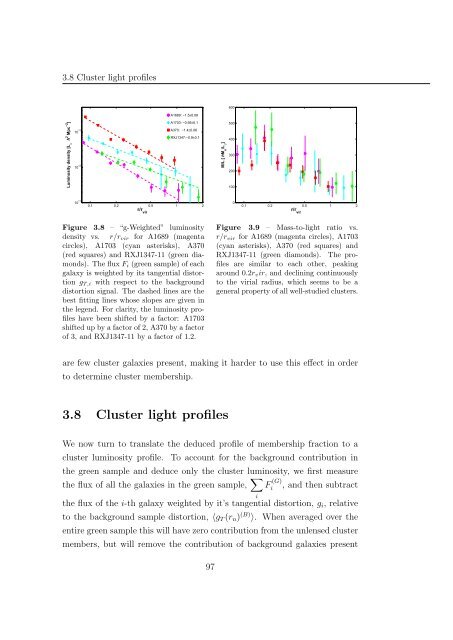Mass and Light distributions in Clusters of Galaxies - Henry A ...
Mass and Light distributions in Clusters of Galaxies - Henry A ...
Mass and Light distributions in Clusters of Galaxies - Henry A ...
Create successful ePaper yourself
Turn your PDF publications into a flip-book with our unique Google optimized e-Paper software.
3.8 Cluster light pr<strong>of</strong>iles<br />
600<br />
A1689: −1.5±0.08<br />
Lum<strong>in</strong>osity density [L ο<br />
h 2 Mpc −2 ]<br />
10 12<br />
A1703: −0.95±0.1<br />
A370: −1.4±0.06<br />
RXJ1347:−0.9±0.1<br />
M/L [ hM o<br />
/L ο<br />
]<br />
500<br />
400<br />
300<br />
200<br />
100<br />
10 11<br />
10 13 r/r vir<br />
0.1 0.2 0.5 1 2<br />
0<br />
0.1 0.2 0.5 1 2<br />
r/r vir<br />
Figure 3.8 – “g-Weighted” lum<strong>in</strong>osity<br />
density vs. r/r vir for A1689 (magenta<br />
circles), A1703 (cyan asterisks), A370<br />
(red squares) <strong>and</strong> RXJ1347-11 (green diamonds).<br />
The flux F i (green sample) <strong>of</strong> each<br />
galaxy is weighted by its tangential distortion<br />
g T,i with respect to the background<br />
distortion signal. The dashed l<strong>in</strong>es are the<br />
best fitt<strong>in</strong>g l<strong>in</strong>es whose slopes are given <strong>in</strong><br />
the legend. For clarity, the lum<strong>in</strong>osity pr<strong>of</strong>iles<br />
have been shifted by a factor: A1703<br />
shifted up by a factor <strong>of</strong> 2, A370 by a factor<br />
<strong>of</strong> 3, <strong>and</strong> RXJ1347-11 by a factor <strong>of</strong> 1.2.<br />
Figure 3.9 – <strong>Mass</strong>-to-light ratio vs.<br />
r/r vir for A1689 (magenta circles), A1703<br />
(cyan asterisks), A370 (red squares) <strong>and</strong><br />
RXJ1347-11 (green diamonds). The pr<strong>of</strong>iles<br />
are similar to each other, peak<strong>in</strong>g<br />
around 0.2r v ir, <strong>and</strong> decl<strong>in</strong><strong>in</strong>g cont<strong>in</strong>uously<br />
to the virial radius, which seems to be a<br />
general property <strong>of</strong> all well-studied clusters.<br />
are few cluster galaxies present, mak<strong>in</strong>g it harder to use this effect <strong>in</strong> order<br />
to determ<strong>in</strong>e cluster membership.<br />
3.8 Cluster light pr<strong>of</strong>iles<br />
We now turn to translate the deduced pr<strong>of</strong>ile <strong>of</strong> membership fraction to a<br />
cluster lum<strong>in</strong>osity pr<strong>of</strong>ile.<br />
To account for the background contribution <strong>in</strong><br />
the green sample <strong>and</strong> deduce only the cluster lum<strong>in</strong>osity, we first measure<br />
the flux <strong>of</strong> all the galaxies <strong>in</strong> the green sample, ∑ F (G)<br />
i , <strong>and</strong> then subtract<br />
i<br />
the flux <strong>of</strong> the i-th galaxy weighted by it’s tangential distortion, g i , relative<br />
to the background sample distortion, 〈g T (r n ) (B) 〉. When averaged over the<br />
entire green sample this will have zero contribution from the unlensed cluster<br />
members, but will remove the contribution <strong>of</strong> background galaxies present<br />
97
















